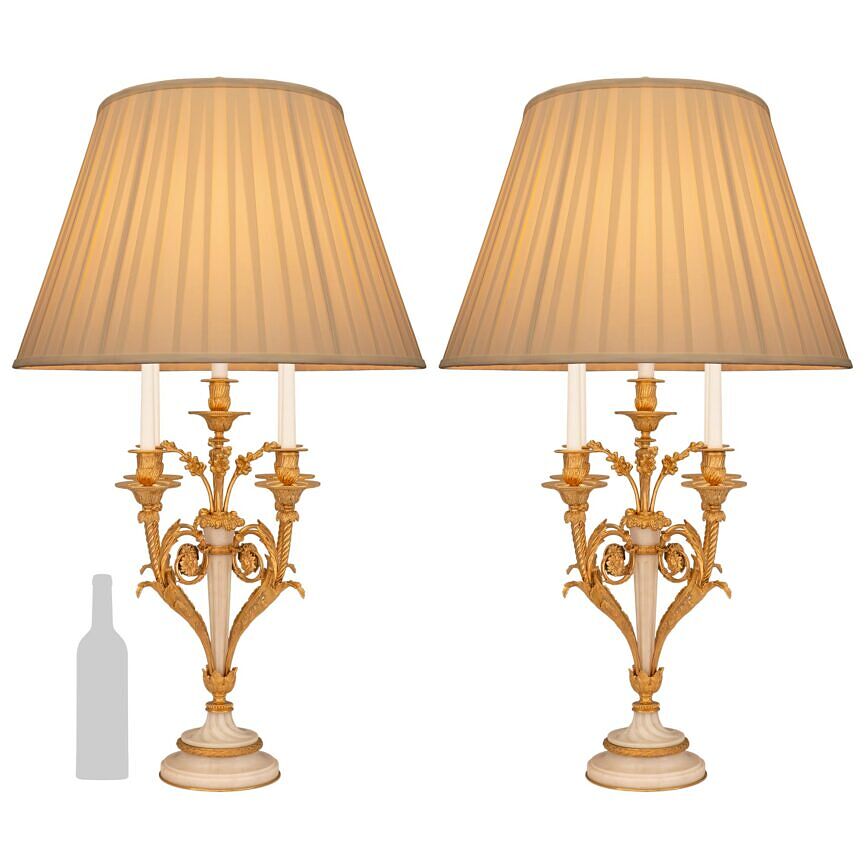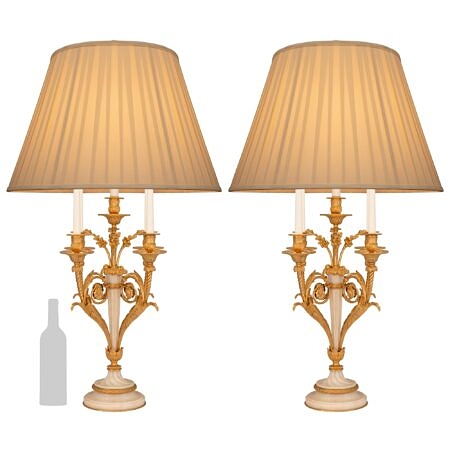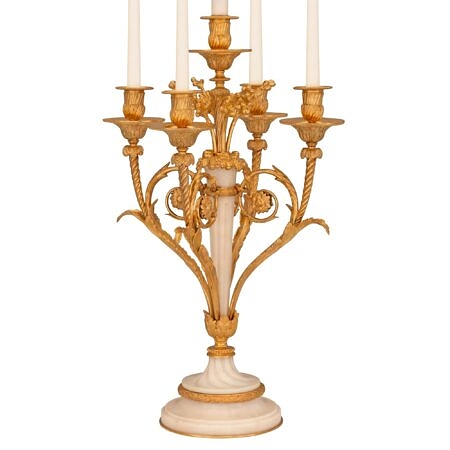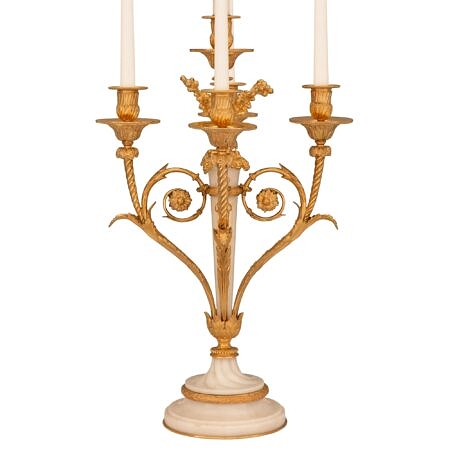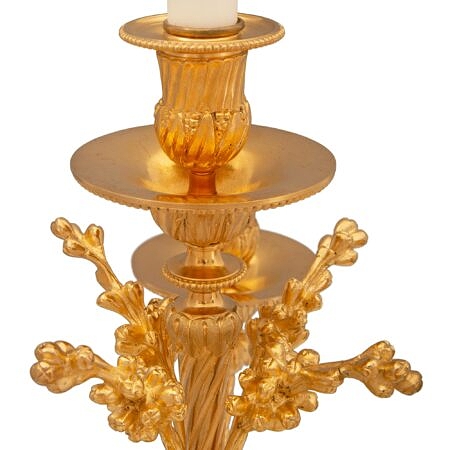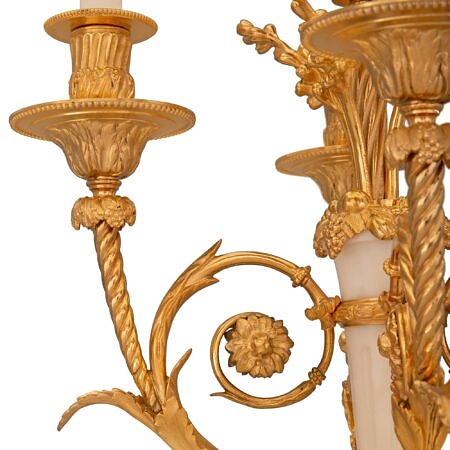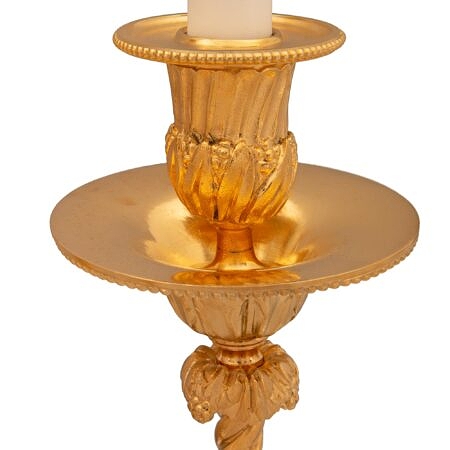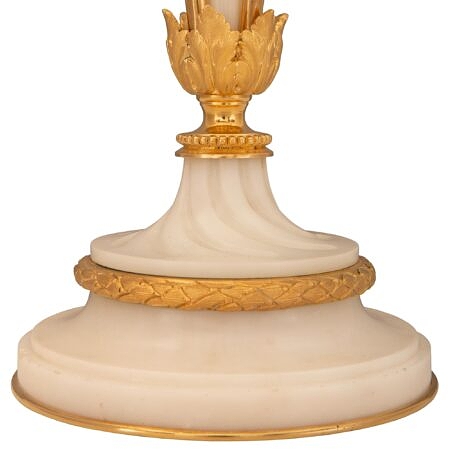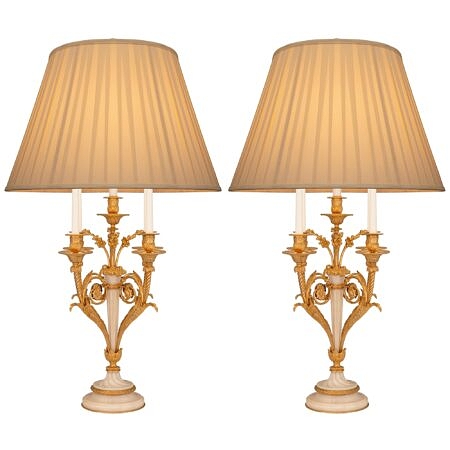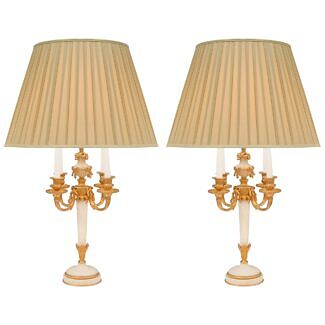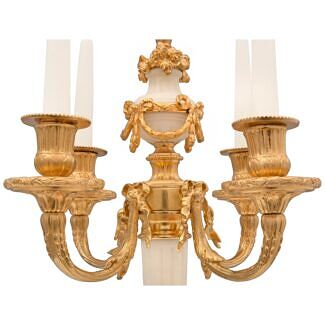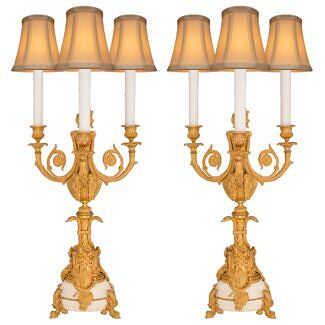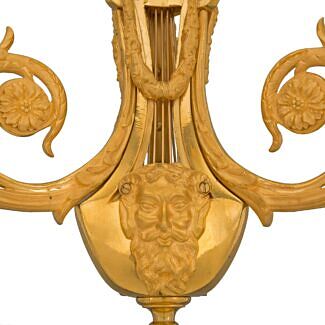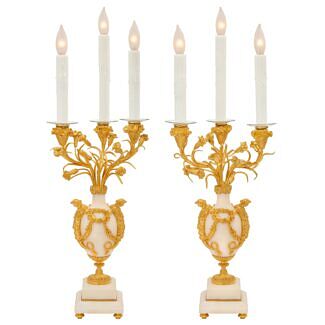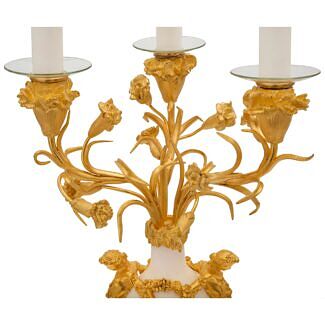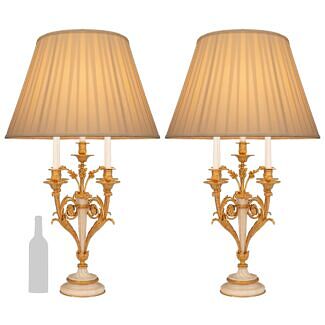A French 19th century Louis XVI st. Belle Époque period candelabra lamps after a model by Pierre Gouthière
A striking and extremely decorative French 19th century Louis XVI st. Belle Époque period candelabra lamps after a model by Pierre Gouthière. Each four arm lamp is raised by an elegant circular white Carrara marble base with a fine bottom... — Read More
A striking and extremely decorative French 19th century Louis XVI st. Belle Époque period candelabra lamps after a model by Pierre Gouthière. Each four arm lamp is raised by an elegant circular white Carrara marble base with a fine bottom ormolu fillet, a beautiful mottled design, and a richly chased wrap around berried laurel band below a superb spiral fluted design at the socle shaped pedestal. The elegant circular tapered white Carrara marble central support leads upwards to beautiful blooming flowers and wheat sprigs centered by exceptional gracefully curved arms. Each arm displays stunning spiral fluted designs and superb scrolled Rinceau movements each adorned with large acanthus leaves leading to lovely floral and beaded bobeches and candle cups with a single arm at the center decorated in the same manner.
Pierre Gouthière (1732-1814) - born Bar-sur-Aube, was known as the best metal worker and gilder of his time and was unsurpassed by any of his rivals. He was the student of François Ceriset who’s workshop he took over in 1758. Under the protection of the duke d’Aumont, he produced works for King Louis XVI and Princess Marie Antoinette and become the sole gilder for the “Menus-Plaisirs du Roi”. He was the inventor of the matte gilding which became know as the beautiful satin and burnished finish noticed on high quality pieces and trained famous bronzier Pierre-Philippe Thomire in his studio. He also produced work for the duchess of Mazarin and Madame du Barry. Unfortunately, most of his work was lost or destroyed but some of his finest and most representative creations can still be admired in the Wallace Collection. — Read Less
All light fixtures have been inspected and rewired to US standards.
- Item # 12760
-
H: 41.25 in L: 11.5 in D: 11.5 in
H: 105 cm L: 29 cm D: 29 cm
- Shade Diameter: 24 in
- France
- 19th Century
- Marble/Stone, Ormolu
-
Belle Époque Period Read More,
Louis XVI st. Read More
(Belle Époque Period) -
Gaining its name from the optimistic and peaceful period of time between 1871 and World War I, Belle Epoque means “beautiful period”, and occurred during the era of the Third French Republic. This period of economic, colonial, and scientific prosperity brought with it a flourishing artistic climate with numerous literal, musical, theatrical, and visual masterpieces being created.
The Eiffel Tower, which was constructed between 1887 and 1889, served as the entrance to the World’s Fair held in Paris. That same year, the Moulin Rouge cabaret in Paris was founded and showcased the now more mainstream styles of performance including can-can dancing. Belle Epoque dancers and singers were Paris celebrities and became immortalized by the poster arts of Toulouse-Lautrec.
Leading up to this period in 1865, the American Civil War was coming to a close, with France proposing to construct the Statue of Liberty as a joint effort with the United States. France would be responsible for the statue, with America constructing the pedestal. Created to celebrate the nation’s success in building a viable democracy, the statue would stand as a symbol of friendship between the French and American people.
(Louis XVI st.) -
Also known as Louis Seize, Louis XVI's style is a style of architecture, furniture, decoration, and art created during Louis XVI’s 19-year reign in France, just before the French Revolution.
Thought to be a reaction and juxtaposition to the prior more elaborate styles, Louis XVI style developed at the end of the Baroque Period and continued until the birth of French Neoclassicism.
King Louis XVI showed little enthusiasm for the old world styles of the Baroque Period and he sought out a create a new “beau ideal” that focused on the purity and grandeur of Ancient Romans and Greeks.
Inspired by Ancient Roman architecture and art, distinct features of the Louis XVI style are linear lines, small repeated motifs, floral medallions hanging from ribbons, acanthus leaves, urns, dolphins, ram, and lion heads, and griffins.
Greco-Roman elements, often used in earlier and later French styles, were also quick common and included fluted and twisted columns, Caryathids, and corbels.
- Pierre Gouthière Read More
Pierre Gouthière (1732-1814) - born Bar-sur-Aube, was known as the best metal worker and gilder of his time and was unsurpassed by any of his rivals. He was the student of François Ceriset and took over his workshop in 1758. Under the protection of the duke d’Aumont, he produced works for King Louis XVI and Princess Marie Antoinette becoming the sole gilder for the “Menus-Plaisirs du Roi” as well as producing work for the duchess of Mazarin and Madame du Barry. He was the inventor of the matte gilding which became known as the beautiful satin and burnished finish noticed on high quality pieces and also trained the acclaimed master bronzier Pierre-Philippe Thomire in his studio. Unfortunately most of his work was lost or destroyed but some of his finest and most representative creations can still be admired in the Wallace Collection.
Payment Plan Option Learn More Choose the payment plan option at checkout and customize this payment option with our team. Payment plans are flexible and items will ship once all payments are received.


